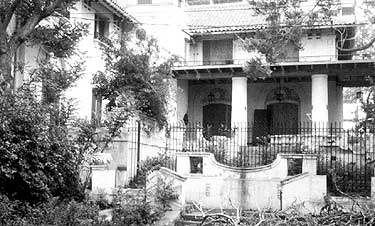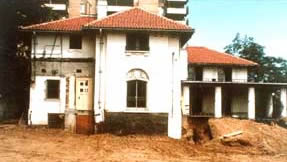



no.7
 If landscape materials and features are
If landscape materials and features are
historically distinctive, DON'T destroy
them!
::issueFOCUS:: Destroying a significant building site
::go to REHAB YES'S::
The
historic character...
An early 20th century Mediterranean villa style house, individually listed
in the National Register of Historic Places, had a formal garden, apparently
conceived as an integral part of the total landscape design. The house
had been vacant for over ten years and, although the garden's architectural
features were deteriorated and the planted areas were severely overgrown,
much of the historic landscape remained. For example, there were terraces
at the front and rear of the building.
...and how it was lost in the rehabilitation.
In preparation for a project that involved re-development of the site
for low-rise apartments, the surviving landscape features—both plant
materials and architectural elements—were destroyed. The proposed
rehabilitation of the house for rental apartments had been considered
exemplary; however, because the demolished walled garden was one of only
a few formally designed gardens in the city that had survived to the present
day, the work did not meet Standard 2. The fact that
the garden had been neglected and was overgrown at the time of rehabilitation
did not lessen its historical significance.
|
After work, the house minus its historic landscape. |
What should you know?
The landscape and landscape features around a historic building are often
important aspects of its character or that of the historic district in
which it is located. Owners always need to be aware of the historical
significance of all elements of a property and its site before making
decisions about destroying or altering historic material.
[TOP IMAGE] Formal garden at rear of the house. NPS Photos.
Standard 2: The historic character of a property shall be retained and preserved. The removal of historic materials or alteration of features and spaces that characterize a property shall be avoided.

